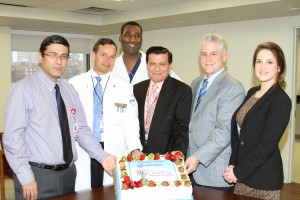Unless you’ve suffered from one, most people only know about hernias from the Weird Al Yankovic song (“Living With A Hernia”). Hernias are caused by pressure on an opening or weakness in the wall of muscle or connective tissue of the groin, belly button or upper stomach that allows a hernia sac (like a balloon) to protrude. An increase in abdominal pressure pushes the hernia sac and its contents (organ or tissue) through the opening or weak spot. The muscle weakness may be present at birth or develop at any age. The most common types of hernia are:
 . Inguinal (inner groin) – fat, intestines, colon or bladder may protrude through the abdominal wall. About 96% of all groin hernias are inguinal, and most occur in men because of a natural weakness in this area.
. Inguinal (inner groin) – fat, intestines, colon or bladder may protrude through the abdominal wall. About 96% of all groin hernias are inguinal, and most occur in men because of a natural weakness in this area.
. Incisional (resulting from an incision) — intra-abdominal organs push through the abdominal wall at the site of previous abdominal surgery. This type is most common in elderly or overweight people who are inactive after abdominal surgery.
. Femoral (outer groin) — occurs when the intestine enters the canal carrying the femoral vessels into the upper thigh. Femoral hernias are most common in women, especially those who are pregnant or obese.
. Umbilical (belly button) — part of the small intestine passes through the abdominal wall at or near the navel. Common in newborns, it also commonly afflicts obese women or those who have had many children.
. Hiatal (upper stomach) — when the upper stomach squeezes through the hiatus, an opening in the diaphragm through which the esophagus passes. These hernias cannot be seen or felt from the outside and majority do not require surgery
Anything that causes an increase in pressure in the abdomen can cause a hernia, including lifting heavy objects without proper support and coughing or sneezing. Obesity, poor nutrition, smoking and prior abdominal surgery, can all weaken muscles and make hernias more likely.
Surgery to repair a hernia is one of the most commonly performed surgeries. Flushing Hospital Medical Center offers minimally invasive robotic procedures using the da Vinci robotic system. Hernia surgery performed using the robot allows for faster healing time, less scarring and shorter hospital stays.
If you are experiencing hernia discomfort and would like to make an appointment with a urologist, please contact the Ambulatory Care Center at 718-670-5486.
All content of this newsletter is intended for general information purposes only and is not intended or implied to be a substitute for professional medical advice, diagnosis or treatment. Please consult a medical professional before adopting any of the suggestions on this page. You must never disregard professional medical advice or delay seeking medical treatment based upon any content of this newsletter. PROMPTLY CONSULT YOUR PHYSICIAN OR CALL 911 IF YOU BELIEVE YOU HAVE A MEDICAL EMERGENCY.



